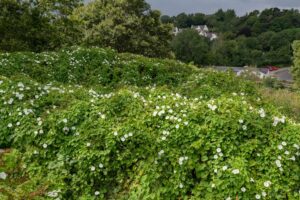What is the Nuisance Weed Hedge Bindweed (Calystegia Sepium)?
Hedge bindweed (Calystegia Sepium), also known as wild morning glory, is a common weed found in gardens, fields, and along roadsides. This perennial vine is known for its aggressive growth and ability to take over other plants and vegetation, making it a significant problem for farmers and homeowners alike.
With its delicate white or pink flowers, hedge bindweed is seen as attractive and may seem harmless to many people, however, its deep roots and extensive underground stems make it extremely difficult to control.
In this article, we will explore the biology and characteristics of hedge bindweed, as well as effective methods for controlling and preventing its spread. Read our frequently asked questions about bindweed below so you are fully aware of what is is and what to do if it appears in your garden.
If you are concerned you have nuisance weeds at your domestic or commercial property, contact us today using 01269 591651 or 07531 142316 and one of our South Wales Knotweed & Nuisance Weeds experts can advise you and arrange a free and no obligation site survey.
What is the appearance of Hedge Bindweed?
Hedge bindweed has a delicate appearance with small, trumpet-shaped flowers, typically white or pink. The leaves are around 2-5 cm long and alternately arranged on the stem. The plant stems of bindweed is typically green or slightly reddish and can be either smooth or hairy.
What is the difference between Field Bindweed
Hedge bindweed (Convolvulus arvensis) and field bindweed (Convolvulus arvensis) is very similar in appearance and often confused. Both plants are perennial vines with small, trumpet-shaped flowers with the same colour and matching leaves. However, one of the main differences between the two is the colour of the stem. Bindweed typically has green or slightly reddish stems, while field bindweed stems are usually more purplish. Another difference is the shape of the flowers. Hedge bindweed flowers are more bell-shaped, while field bindweed flowers are more tubular.
What are the characteristics of Bindweed?
Hedge bindweed has several key characteristics that you can use to identify the species:
Perennial vine
Bindweed is a perennial plant, meaning it can live for more than one year. It typically grows to a height of 1-2 meters and can be found in gardens, fields, and along roadsides.
Twining growth habit
It has a twining growth habit, wrapping around other plants and suffocating them by overgrowing.
Extensive root system
Bindweed roots have a deep and extensive root system consisting of a taproot and underground stems, or rhizomes, which makes it difficult to control and eradicate. The plant roots of this invasive plant are capable of producing shoot growth that’s unmatched.
Aggressive growth
It is known for its aggressive growth habits, which will quickly take over other plants and make them difficult to control.
Resilient
Hedge bindweed is very resilient; it can survive in all soil types, climates and conditions. It can grow in poor soil, drought, and heavy shade, again making it very difficult to control and remove.
How does Bindweed reproduce?
Bindweed reproduces through seeds, underground stems, roots, and fragmentation. The plant produces tiny, round, brown or black seeds that can remain viable in the soil for several years and germinate when conditions are favourable. It also reproduces through underground stems, known as rhizomes, which can grow deep into the ground and produce new shoots that grow into new plants.
Additionally, hedge bindweed can reproduce by rooting at the stem nodes, where new plants will grow from the roots. Fragmentation is another way bindweed propagates itself; it can happen when a piece of the stem or root breaks off and grows into a new plant.
This ability to reproduce in multiple ways makes bindweed a tough plant to control or completely eradicate. It can quickly colonise new areas, and even small fragments of stem or root can grow into new plants.
Why is Bindweed dangerous?
Hedge Bindweed is a destructive weed that can have consequences on your property. The plant has an aggressive growth habit and can quickly take over other plants, making it difficult for them to compete for the sunlight and nutrients that they need. At times, it can take over gardens, fields, and other cultivated areas, reducing crop yields and making it hard to grow other plants.
The weed also reproduces both by its seeds and by spreading underground root systems, which allows it to colonise new areas quickly, and it doesn’t help that it is remarkably resilient. It can survive in various soil types, climates, and conditions.
Lastly, bindweed can also harm natural habitats by taking over and displacing native plants, which can disrupt the ecosystem and the animals that depend on it.

How can you control Bindweed?
There are several methods for controlling hedge bindweed, including:
Physical Removal
Regularly pulling or digging up the plants can effectively control hedge bindweed, but it’s important to remove as much of the root system as possible to prevent regrowth. This method is best used for small infestations so if you recognise it in your garden remove it quickly before its rapid growth.
Using Herbicides
There are several herbicides that can control bindweed, including glyphosate and dicamba. However, you should follow the manufacturer’s instructions and apply the herbicide at the appropriate time for maximum effectiveness. There are many herbicides that can only be used by authorised businesses so always check carefully before attempting it and use goggles and protective clothing.
Biological Control
Some insects, such as the bindweed gall mite, can help manage hedge bindweed. However, consider the potential impact on non-target species and the environment before using biological control methods.
Prevention
One of the best ways to control bindweed is to prevent it from spreading in the first instance by completely removing it from the soil including its roots and seeds.
Combining the removal methods often works best, as hedge bindweed is a very persistent and resilient weed. You must be persistent with the control methods, as it usually takes several years of consistent control effort to manage bindweed effectively.
In Summary
A Hedge Bindweed infestation in your garden can have an impact on your other vegetation as well as change the look and feel of your garden. It often also encroaches on other plants that you love, takes over, and changes a whole habitat. However, you can keep the invasive species at bay with the right information and appropriate methods.
If you think you may have bindweed in your garden or on your land then contact Green Leaf Remediation today and we can offer you advice of the best ways to control it or come out to your property to conduct a site assessment.
About Green Leaf Remediation
In addition to being a Japanese Knotweed Certificated Surveyor (JKCS), we also specialise in identifying and controlling other invasive plants and nuisance weeds including Hedge Bindweed which are all found throughout the UK. We are qualified specialists in using herbicide treatments according to the vegetation around your property and the property itself.
Our NPTC-qualified chainsaw operators also provide tree services, such as pollarding, crowning, pruning, and felling, with a wealth of forestry experience.
Our Qualifications & Accreditations
-
- City & Guilds NPTC Level 2
- Principles of Safe Handling & Application of Pesticides (PA1/PA6)
- Principles of Safe Handling & Application of Pesticides near water (PA6AW)
- Herbicide Stem Injection
- Member of the Property Care Association
- The Control & Eradication of Japanese Knotweed Surveyor’s Training Course
- Qualified Technician (PCAQT) in Japanese Knotweed
- Accredited Surveyor in Japanese Knotweed
Why Choose Us?
Green Leaf Remediation has many years of experience in the weed, garden and site management industry and we are experts in all the services we provide.
The customer is at the heart of what we do and all of our team members always strive to do a great job and offer the very best customer service. You can read our testimonials here.
All members of our team are qualified and have the necessary experience for the job and we only send them to a job if they meet the qualifications and skills required.
We provide free site assessments and will carry out any work you instruct us to perform, as long as we don’t violate any UK laws and we can help you understand any relevant legislation and support you in achieving it.
For all jobs and projects we carry out, we have full public liability and professional indemnity insurance.
We offer a wide range of professional services at Green Leaf Remediation. Throughout Wales and the South West, our customers highly recommend us for our professionalism and courteousness.
No job is too big or small for us and we take on large or small projects giving you a realistic timescale for completion.
We offer a range of services to suit your needs whether it is a one-off job or regular maintenance visits.
Our team will answer any questions you may have and can arrange a site visit for your home, business or commercial land.
Don’t delay in contacting us as the sooner we come out to your property the sooner we can advise you of your best options.
Contact us today at 01269 591651 or 07531 142316 if you think you may have Hedge Bindweed or any other invasive weed including Japanese Knotweed. If you are purchasing land, a commercial or residential property that they may be present on we can come out and conduct a full site assessment for you.
One of our experts will be able to quickly assess any infestation you have and offer you the best method of control or removal using one of our safe and environmentally friendly solutions. You can also book a site survey here.

Martyn works for Green Leaf Remediation as a marketing specialist. He takes great pride in creating quality content regarding Japanese knotweed.
